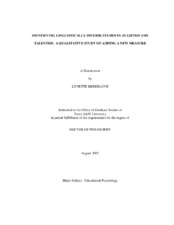| dc.description.abstract | As the population of linguistically diverse students in schools increases, so should the representation of these students in gifted and talented programs. This is a struggle for many schools districts where the ethnic diversity in the district is not reflected in the students identified as gifted. The objective of this study was to examine teachers’ perspectives regarding students identified as gifted and talented through the addition of the Bilingual Verbal Abilities Test (BVAT) to the identification process. The researcher interviewed teachers to determine if they perceived the linguistically diverse students identified using the new measure to be gifted and talented, and what characteristics the teachers believed led to their being identified. In addition, the teachers were asked if they believed students should have been identified as gifted but were not despite the use of the new measure, and what the teachers believed were the barriers preventing identification. The use of the BVAT resulted in the identification of students the teachers perceived to be gifted; however, teachers described a number of students who were missed. Teachers overwhelmingly described the linguistically diverse students they perceived to be gifted as having advanced language skills, particularly in reading. The teachers rely on their experience in the classroom with students to help them determine which students to refer for testing, rather than training they have completed. The greatest barrier to identification that was identified by the teachers was language. They discussed the lack of students’ language development (despite their advanced abilities) and the unusually high level of language required on standardized assessments. Finally, teachers suggested using a test preparation approach to improve the identification process, and to test linguistically diverse students for the gifted program repeatedly. | en |


